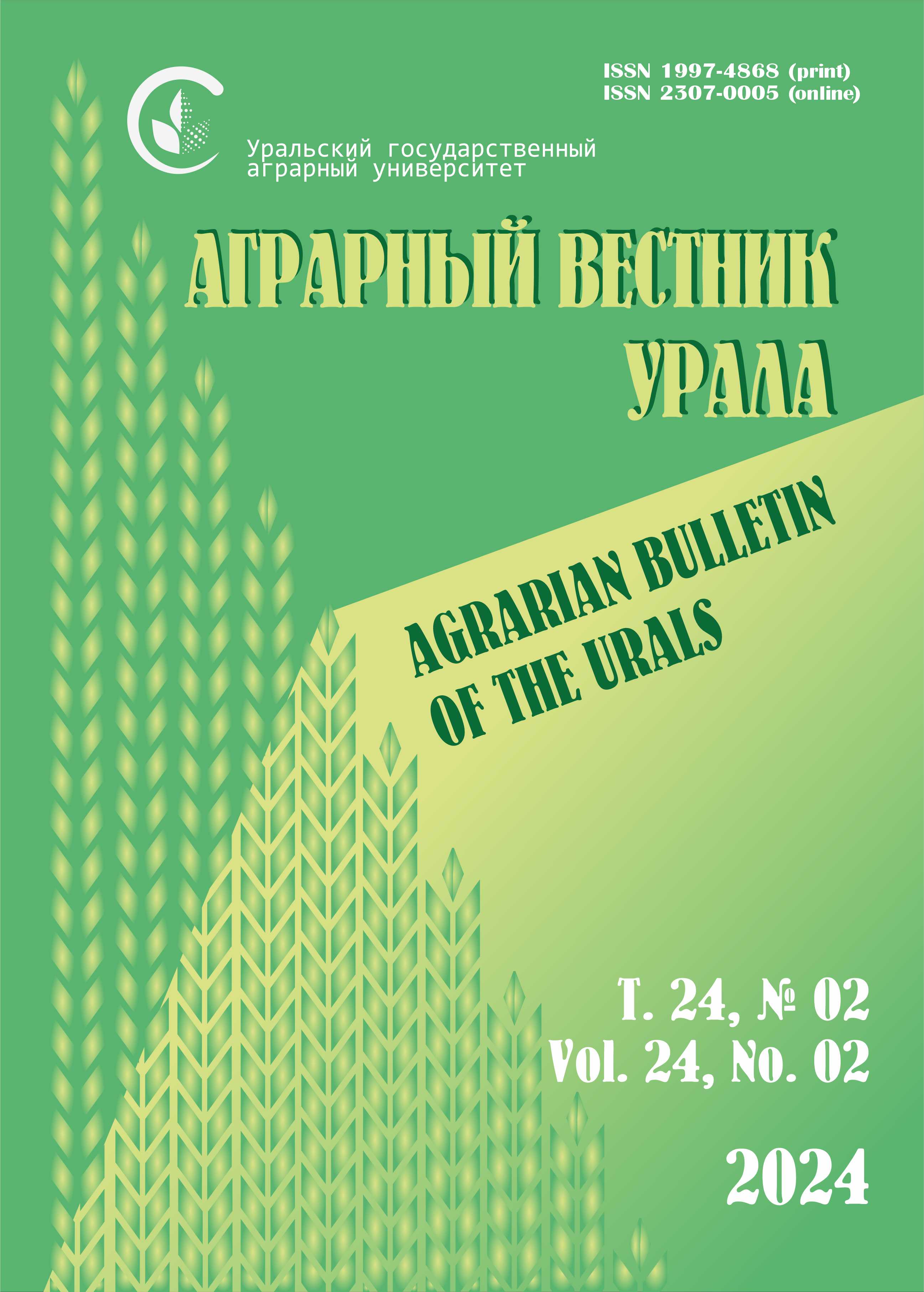Abstract. Purpose of the study is analysis of productive and reproductive qualities of the Holstein cattle of the Tyumen region in comparison with the leading American enterprises using genomic selection. Materials and methods. Zootechnical, statistical and economic methods were used. As part of the work, the tasks were solved to consider the growth and development of replacement young animals; the main indicators of reproduction of heifers and cows of the main herd were analyzed; the milk productivity of cows and first-calf heifers was estimated according to the primary accounting data; a zootechnical assessment of sires used in the economy was carried out; the results of the genomic assessment were compared with the actual milk production. The scientific novelty of the work lies in the fact that genotyping was carried out in the conditions of a large industrial complex, because the use of genomic evaluation was not widely used in farms in the Russian Federation. Research results. The indicators of the intensity of growth of replacement young animals grown in the conditions of the Evika-Agro enterprise correspond to the world standards of the breed, and in some cases exceed them. The intensity of growing heifers allows for earlier insemination, which also contributes to early calving - 98% of animals calve up to 25 months of age. Estimates of milk production are largely consistent with those of advanced farms in the United States. “Evika-Agro” LLC uses outstanding sires from the world’s gene pool to improve economically useful traits, thereby accelerating the rate of selection. Analysis of the genomic assessment showed a significant discrepancy between the genetic basis of milk production and the actual level of milk production. This is most noticeable in the lifetime earnings index ($ 682) and the average increase in milk per lactation (916.2 kg) between the worst and best heifers in the sample.
Holstein breed, zootechnical evaluation, productive qualities, genomic evaluation, genomic selection, genetic potential
1. Fessende B., Weigel D. J., Osterstock J., Galligan D. T., Di Croce F. Validation of genomic predictions for a lifetime merit selection index for the US dairy industry // Journal of Dairy Science. 2020. Vol. 103. Pp. 10414-10428.
2. Kosyachenko N. M. Abramova M. V., Lapina M. Yu. Harakteristika produktivno-hozyaystvennyh pokazateley korov yaroslavskoy porody razlichnyh genotipov // Agrarnyy vestnik Urala. 2020. № 1. S. 43-52. DOI:https://doi.org/10.32417/1997-4868-2020-192-1-43-52. EDN: https://elibrary.ru/JVAFXK
3. Associaciya golshtincev SShA [Elektronnyy resurs]. URL: http://www.holsteinusa.com (data obrascheniya: 10.05.2023).
4. Krivopushkin V. V., Krivopushkina E. A. Prodolzhitel'nost' i effektivnost' proizvodstvennogo ispol'zovaniya cherno-pestryh korov raznyh tipov i konstitucii v usloviyah Bryanskoy oblasti // Vestnik Bryanskoy GSHA. 2020. № 1 (77). S. 38-44. EDN: https://elibrary.ru/HDRWCQ
5. Podol'nikov V. E., Podol'nikov M. V., Golubov A. N. Reproduktivnye kachestva bykov-proizvoditeley pri ispol'zovanii v ih kormlenii raznyh po sostavu racionov // Vestnik Bryanskoy GSHA. 2019. № 1 (71). S. 46-51. EDN: https://elibrary.ru/YVQJTV
6. Abylkasymov D., Sudarev N. P., Chargeishvili S. V. Effektivnost' ispol'zovaniya vysokoproduktivnyh korov raznoy selekcii v usloviyah intensivnoy tehnologii proizvodstva moloka. Tver': Vserossiyskiy nauchno-issledovatel'skiy institut plemennogo dela, 2020. 134 s. EDN: https://elibrary.ru/HOEIBF
7. Bykova O. A., Kostyunina O. V., Stepanov A. V., Shevkunov O. A. Identifikaciya SNP, associirovannyh s vosproizvoditel'noy sposobnost'yu krupnogo rogatogo skota // Agrarnyy vestnik Urala. 2023. № 6 (235). S. 53-66. DOI:https://doi.org/10.32417/1997-4868-2023-235-06-53-66. EDN: https://elibrary.ru/FLYJKK
8. Kabickaya Ya. A., Kalashnikova L. A., Boyko E. G., Kalashnikov A. E. Geneticheskaya identifikaciya kak kriteriy sovpadeniy s dannymi pervichnogo ucheta zhivotnyh na territorii UFO // Vestnik Ryazanskogo gosudarstvennogo agrotehnologicheskogo universiteta im. P. A. Kostycheva. 2020. № 1 (45). S. 114-120. DOI:https://doi.org/10.36508/RSATU.2020.45.1.020. EDN: https://elibrary.ru/NYJZEF
9. Lebed'ko E. Ya., Pilipenko R. V. Geneticheskiy potencial rekordnoy molochnoy produktivnosti korov golshtinskoy porody // Effektivnoe zhivotnovodstvo. 2020. № 1 (158). S. 9-13. EDN: https://elibrary.ru/HLXFAG
10. Mudarisov R. M., Hakimov I. N., Semenov V. G., Kul'makova N. I. Molochnaya produktivnost' korov golshtinskoy porody v Yuzhno-lesostepnoy zone Predural'ya // Izvestiya Samarskoy gosudarstvennoy sel'skohozyaystvennoy akademii. 2020. № 3. S. 32-39. DOI:https://doi.org/10.12737/38766. EDN: https://elibrary.ru/CJGIFC
11. Sheveleva O. M., Bakharev A. A. Meat productivity of french-bred bulls due to adaptive technology in Western Siberia // Siberian Journal of Life Sciences and Agriculture. 2022. Vol. 14. No. 4. Pp. 370-383. DOI:https://doi.org/10.12731/2658-6649-2022-14-4-370-383. EDN: https://elibrary.ru/BNQCIU
12. Koshelev S. N., Bakharev A. A., Romanova O. V. Intensity of ecotoxicants' accumulation in internal organs and milk of dairy cows in the north-west of Transurals // E3S Web of Conferences. International Conference “Ensuring Food Security in the Context of the COVID-19 Pandemic” (EFSC2021). Doushanbe, Republic of Tadjikistan, 2021. Article number 02005. DOI:https://doi.org/10.1051/e3sconf/202128202005. EDN: https://elibrary.ru/ZBEBWJ
13. Gorelik O. V., Fedoseeva N. A., Kiselev L. Yu., Soynova O. L., Sanova Z. S. Chastota doeniya korov - Put' k uvelicheniyu molochnoy produktivnosti v usloviyah robotizirovannyh ferm // Agrarnyy vestnik Urala. 2018. № 11 (178). S. 27-32. DOI:https://doi.org/10.32417/article_5c6a6e23a3da76.82983272.
14. Kabitskaya Y. A., Boyko E. G. Genetic diversity of cattle bred in territory of the Tyumen region, Russia // Archives of Razi Institute. 2021. Vol. 76. No. 3. Pp. 681-690. DOI:https://doi.org/10.22092/ARI.2021.355325.1673. EDN: https://elibrary.ru/ABWTMB
15. Bakharev A. A., Sheveleva O. M., Fomintsev K. A., Grigoryev K. N., Koshchaev A. G., Amerkhanov K. A., Dunin I. M. Biotechnological Characteristics of Meat Cattle Breeds in the Tyumen Region // Journal of Pharmaceutical Sciences and Research. 2018. Vol. 10 (9). Pp. 2383-2390. EDN: https://elibrary.ru/GYEGGS
16. Cherechecha A. A., Kulikova N. I., Nimbona K. Soderzhanie i ispol'zovanie plemennyh korov golshtinskoy porody v usloviyah intensivnoy tehnologii // Politematicheskiy setevoy elektronnyy nauchnyy zhurnal Kubanskogo gosudarstvennogo agrarnogo universiteta. 2020. № 155. S. 178-193. DOI:https://doi.org/10.21515/1990-4665-155-014. EDN: https://elibrary.ru/JFVSTB
17. Vliyanie genomiki [Elektronnyy resurs]. URL: http://uscdcb.com/genomic-impact (data obrascheniya: 25.04.2023).
18. Mueller M. L., Van Eenennaam A. L. Synergistic power of genomic selection, assisted reproductive technologies, and gene editing to drive genetic improvement of cattle // CABI Agriculture and Bioscience. 2022. Vol. 3. Article number 13. DOI:https://doi.org/10.1186/s43170-022-00080-z. EDN: https://elibrary.ru/ZPNAGG
19. Van Raden P. M., Symposium review: How to implement genomic selection // Journal of Dairy Science. 2020. Vol. 103. Iss. 6. Pp. 5291-5301.
20. Nacional'naya associaciya zhivotnovodov [Elektronnyy resurs]. URL: http://www.naab-css.org/news/april-2020-genetic-base-change (data obrascheniya: 10.05.2023).









